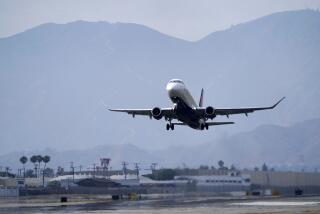Is Our Sky Becoming Overcrowded?
- Share via
There’s been a lot of discussion lately about the safety of our airspace.
Every so often a newspaper or magazine will tell us that the number of reported midair near-misses--or near-collisions--is at an all-time high.
Are our skies as dangerous as they are often depicted? Are they congested?
The answers are no and yes, according to T. Allan McArtor, administrator at the Federal Aviation Administration.
Is our air traffic control system overworked? Can the problems facing it be solved?
Yes and yes, McArtor says.
McArtor was in Anaheim recently to attend the annual conference of the Air Traffic Control Assn., a non-government organization dedicated to furthering the cause of flight safety, among other things.
Perceptions a Problem
McArtor and other speakers, including top airline officials, put a great deal of blame for the public’s perception--or misperception--of the crowded skies on overly dramatic written or televised reports.
Robert Crandall, chairman and chief executive of American Airlines, spoke of a “media feeding frenzy” surrounding aviation near-miss/near-collision incidents.
Jeffrey Erickson, president of Chicago-based Midway Airlines, said press coverage had left the public with a “fuzzy” picture at best of how the air traffic control system operated.
In the case of air safety, maybe there’s a grain of truth in what Crandall and Erickson said. At times it seems that the media do make a lot of fuss about some unthreatening incidents.
That view is shared by many private and commercial pilots and air traffic controllers.
Reportable, Not Threatening
One airline pilot, flying a Boeing 727, recently spotted a private plane, apparently in the wrong airspace, below him as he began his descent into a major Midwestern airport.
He did not consider it a life-threatening encounter, but he did consider it reportable.
A few days later, he read a newspaper account of a “near-miss” at the airport and realized with surprise that the situation described was the one in which he had been involved.
He said the incident happened 17 miles from the runway and over unpopulated land; the small plane never came close to a collision. But he thought the newspaper account implied that the two aircraft almost brushed one another at the end of the runway.
One of the problems, perhaps, is that the FAA hasn’t defined “near-collision” or “near-miss.”
Obviously, when wide-body Delta and Continental jets miss each other by 100 feet over the Atlantic Ocean, as they did earlier this year, it is clearly a near-collision.
Ditto when a Pan Am Airbus and a Viasa DC-10 fly within 300 feet of one another over Bermuda, as they did last summer.
Lumping Statistics Together
There can be no argument that those are “critical” (air-control jargon) encounters. But statistics quoted in the news media often include “potential” and “no hazard” situations.
A pilot following FAA guidelines will report such incidents as midair irregularities, and they may end up being lumped together with the serious cases under the label of “near-miss.”
In some situations, one or both crews must take action to avoid the other aircraft, but it needn’t be a violent maneuver that knocks people to the floor and sends books and glasses flying in the cabin.
In some cases, no action is required.
In 1985, the FAA really began to press pilots to report situations in which they believed airspace rules had been violated. Part of the increase in reported near-misses can probably be attributed to better reporting practices.
There are dangers in our congested skies. McArtor doesn’t deny that. Nor does Crandall or Erickson.
Control System Needs Help
Ideally, of course, the air traffic control system should be improved to a point where it can cope efficiently with all air traffic. More controllers are needed, and they need new, state-of-the-art electronic equipment.
The alternative is the eventual collapse of the world’s best air-control and air-transportation system.
More to Read
Inside the business of entertainment
The Wide Shot brings you news, analysis and insights on everything from streaming wars to production — and what it all means for the future.
You may occasionally receive promotional content from the Los Angeles Times.










